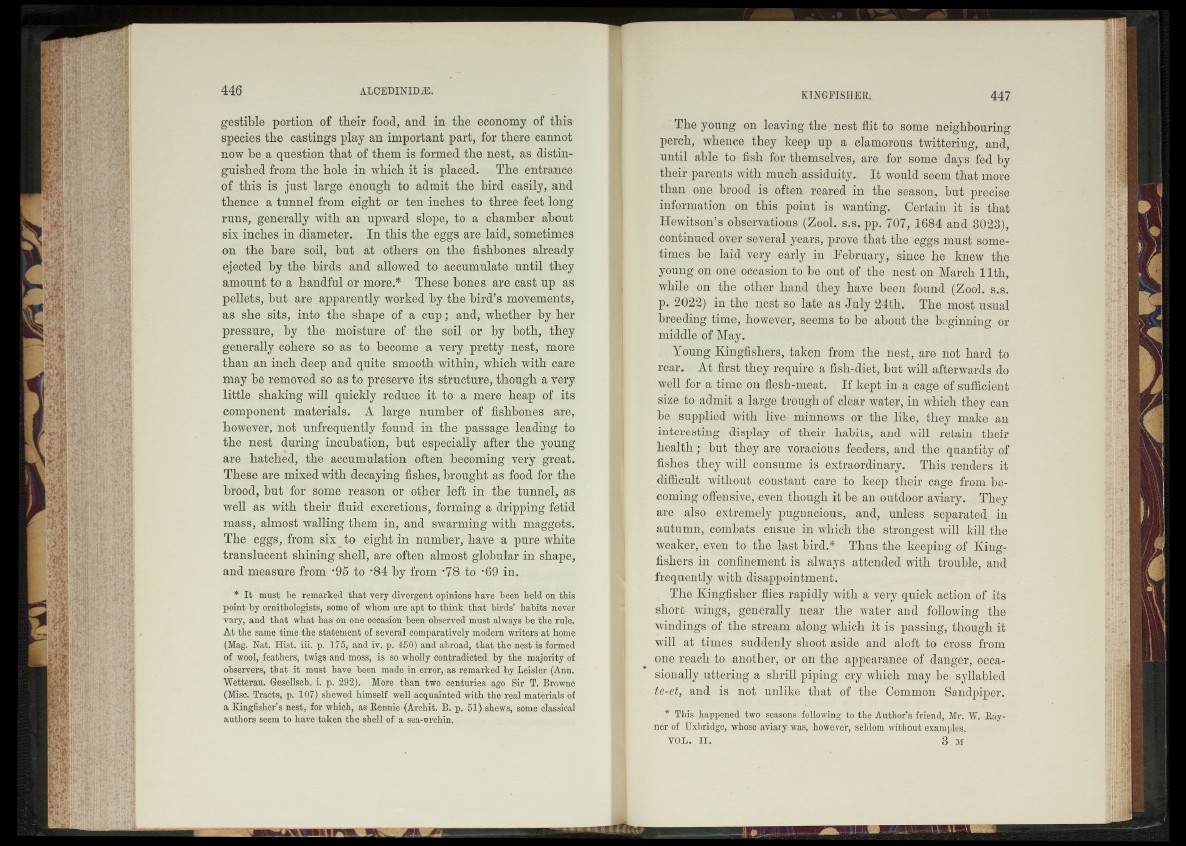
gestible portion of their food, and in the economy of this
species the castings play an important part, for there cannot
now he a question that of them is formed the nest, as distinguished
from the hole in which it is placed. The entrance
of this is just large enough to admit the bird easily, and
thence a tunnel from eight or ten inches to three feet long
runs, generally with an upward slope, to a chamber about
six inches in diameter. In this the eggs are laid, sometimes
on the bare soil, but at others on the fishbones already
ejected by the birds and allowed to accumulate until they
amount to a handful or more.* These bones are cast up as
pellets, but are apparently worked by the bird’s movements,
as she sits, into the shape of a cup; and, whether by her
pressure, by the moisture of the soil or by both, they
generally cohere so as to become a very pretty nest, more
than an inch deep and quite smooth within, which with care
may be removed so as to preserve its structure, though a very
little shaking will quickly reduce it to a mere heap of its
component materials. A large number of fishbones are,
however, not unfrequently found in the passage leading to
the nest during incubation, but especially after the young
are hatched, the accumulation often becoming very great.
These are mixed with decaying fishes, brought as food for the
brood, but for some reason or other left in the tunnel, as
well as with their fluid excretions, forming a dripping fetid
mass, almost walling them in, and swarming with maggots.
The eggs, from six to eight in number, have a pure white
translucent shining shell, are often almost globular in shape,
and measure from *95 to •84 by from *78 to *69 in.
* I t must be remarked that very divergent opinions have been held on this
point by ornithologists, some of whom are apt to think that birds’ habits never
vary, and that what has on one occasion been observed must always be the rule.
At the same time the statement of several comparatively modern writers at home
(Mag. Nat. Hist. iii. p. 175, and iv. p. 450) and abroad, that the nest is formed
of wool, feathers, twigs and moss, is so wholly contradicted by the majority of
observers, that it must have been made in error, as remarked by Leisler (Ann.
Wetterau. Gresellseh. i. p. 292). More than two centuries ago Sir T. Browne
(Misc. Tracts, p. 107) shewed himself well acquainted with the real materials of
a Kingfisher’s nest, for which, as Rennie (Archit. B. p. 51) shews, some classical
authors seem to have taken the shell of a sea-urchin.
The young on leaving the nest flit to some neighbouring
perch, whence they keep up a clamorous twittering, and,
until able to fish for themselves, are for some days fed by
their parents with much assiduity. It would seem that more
than one brood is often reared in the season, but precise
information on this point is wanting. Certain it is that
Hewitson’s observations (Zool. s.s. pp. 707, 1684 and 3028),
continued over several years, prove that the eggs must sometimes
be laid very early in February, since he knew the
young on one occasion to be out of the nest on March 11th,
while on the other hand they have been found (Zool. s.s.
p. 2022) in the nest so late as July 24th. The most usual
breeding time, however, seems to be about the beginning or
middle of May.
Young Kingfishers, taken from the nest, are not hard to
rear. At first they require a fish-diet, but will afterwards do
well for a time on flesh-meat. If kept in a cage of sufficient
size to admit a large trough of clear water, in which they can
be supplied with live minnows or the like, they make an
interesting display of their habits, and will retain their
health ; but they are voracious feeders, and the quantity of
fishes they will consume is extraordinary. This renders it
difficult without constant care to keep their cage from becoming
offensive, even though it be an outdoor aviary. They
are also extremely pugnacious, and, unless separated in
autumn, combats ensue in which the strongest will kill the
weaker, even to the last bird.* Thus the keeping of Kingfishers
in confinement is always attended with trouble, and
frequently with disappointment.
The Kingfisher flies rapidly with a very quick action of its
short wings, generally near the water and following the
windings of the stream along which it is passing, though it
will at times suddenly shoot aside and aloft to cross from
one reach to another, or on the appearance of danger, occasionally
uttering a shrill piping cry which may be syllabled
te-et, and is not unlike that of the Common Sandpiper.
* This happened two seasons following to tbe Author's friend, Mr. W. Ray-
ner of Uxbridge, whose aviary was, however, seldom without examples.
VOL. I I. 8 M